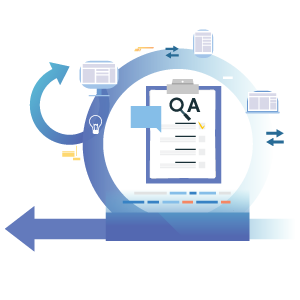Quality & Processes
Quality assurance (QA) is a systematic process that ensures products, services, or processes meet specific quality standards. The QA process involves a series of planned activities designed to prevent defects, identify and address issues, and improve overall quality.
Quality assurance (QA) processes involve several key steps to ensure the quality and reliability of software applications. Here is a detailed outline of the QA process:

 Requirement Analysis
Requirement Analysis
- Understand the project requirements and objectives.
- Identify the key functionalities and features to be tested.
- Analyse the acceptance criteria and define the scope of testing.
 Test Planning
Test Planning
- In this phase we create a test plan that outlines the testing approach, objectives, and timelines.
- Define the test levels (such as system testing, integration testing, and user acceptance testing) and their corresponding entry and exit criteria.
- Identify the test deliverables, resource requirements, and risks.
 Test Case Design
Test Case Design
- We Identify the test scenarios based on the requirements.
- Develop detailed test cases that cover all aspects of the application's functionality.
- Specify the test steps, expected results, and test data requirements for each test case.
- Prioritize test cases based on risk analysis and criticality.
 Test Environment Setup
Test Environment Setup
- Test environment setup includes establishing the required test environment, including hardware, software, and network configurations.
- Install and configure the application or system under test (AUT).
- Prepare the test data, ensuring its accuracy and relevancy.
 Test Execution
Test Execution
- Execute the test cases manually based on the test plan and test scenarios.
- Log the actual results, including any deviations or issues encountered during testing.
- Adhere to the defined test design techniques and best practices for thorough test coverage.
 Defect Reporting and Tracking
Defect Reporting and Tracking
- Define Log defects/bugs encountered during testing in a defect tracking system or issue management tool.
- Provide clear and detailed information about each defect, including steps to reproduce, environment details, and supporting artifacts.
- Assign priorities and severities to reported defects.
 Defect Management
Defect Management
- Team Collaborate with developers and other stakeholders to investigate and resolve reported defects.
- We verify fixed defects and perform regression testing to ensure the fixes did not introduce new issues.
- Track the status of defects, communicate updates to stakeholders, and close resolved defects.
 Test Reporting and Metrics
Test Reporting and Metrics
- Prepare test summary reports, including test coverage, defect statistics, and overall quality assessment.
- Analyse and report key metrics, such as test case execution progress, defect density, and test coverage.
- Provide insights and recommendations for improving the application's quality.
 Test Closure
Test Closure
- Conduct a test closure meeting to review the testing activities and results.
- Perform a lessons learned session to identify areas of improvement and best practices for future projects.
- Archive test artifacts, including test cases, test data, and test environments, for future reference.
The above process followed by us is a comprehensive framework for testing within the QA process. We ensure that we adapt and customize these steps based on the specific need and requirement of any organization and project.
CMMI Level 3 Appraised and an ISO 9001:2008 certified offshore software development company with a strong team of highly skilled IT experts, catering its global clientele with innovative cost-effective solutions across different industry verticals.
Our expertise in technology and business may recommend other features and functionalities not visualized by the client, such as system metrics, performance indicators, content management, backup and restore features, performance enhancer techniques, etc.
Processes are tailored to tune in with specific project and client requirements ensuring management and control for the development processes
Our modular design, may use prototyping to develop a fast and workable application that saves time and money before building the final application.









